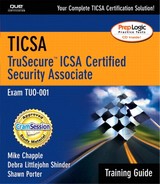Chapter 8. Operating System Security
OBJECTIVES
This chapter covers the following TruSecure-specified objectives for the TICSA exam:
Explain, identify, or recognize fundamentals of Operating System security.
This exam objective ensures that you are familiar with the specific steps required to secure operating systems, such as Microsoft Windows and Unix.
OUTLINE
General Operating System Security 257
Patches, Service Packs, and Hot Fixes 257
STUDY STRATEGIES
TruSecure created the TICSA credential to recognize security practitioners with real-world experience. To meet this goal, the exam is heavily focused toward practical applications of security principles. Therefore, the TICSA exam contains a large number of questions centered around the Windows and Unix platforms. A solid foundation in at least one of these operating systems is essential for successful completion of the test.
To successfully attack all the questions on the exam, you should be familiar with Windows 2000 and Active Directory concepts. You'll certainly be able to pass the test without mastering these topics, but they could make the difference if you're weak in other areas.
There are hundreds of versions of Unix and Linux available today and each one is slightly different from the others. Don't worry about this on the TICSA exam. You'll see only questions that are generally applicable to all flavors of Unix/Linux.
When reviewing the information contained in this chapter, keep in mind the lessons learned in previous sections of the book. Skim back through previous chapters and think about how the material presented applies to the specific operating systems discussed here.
